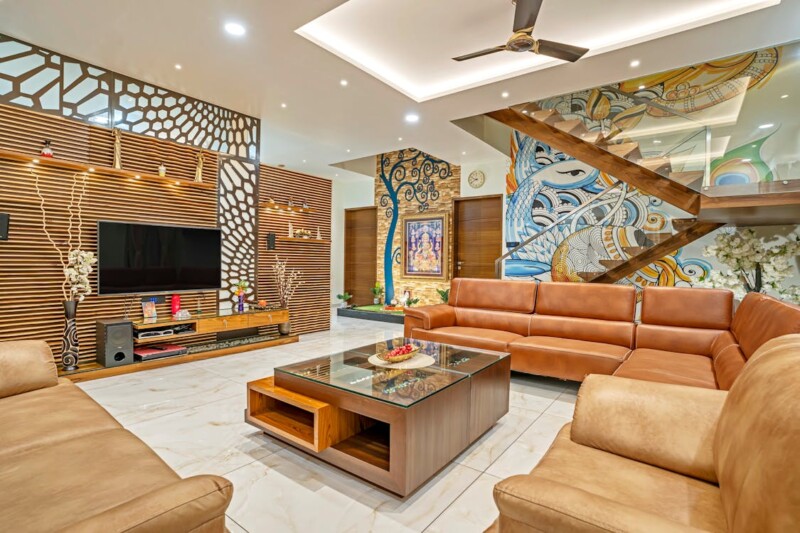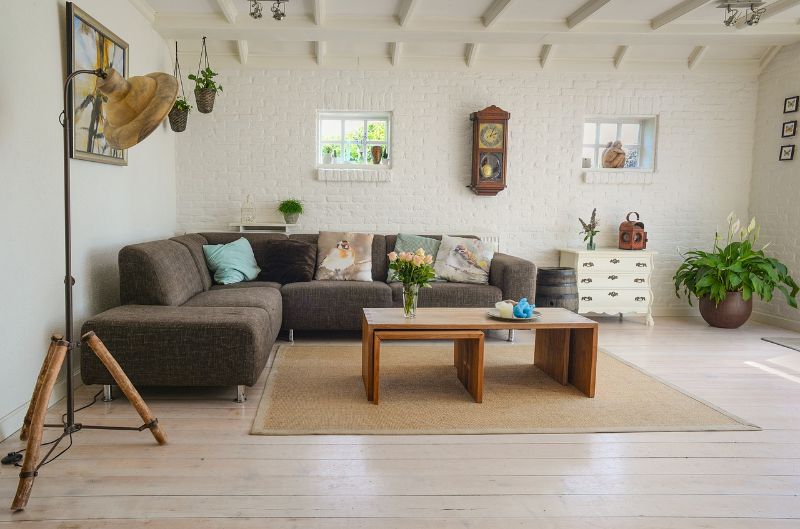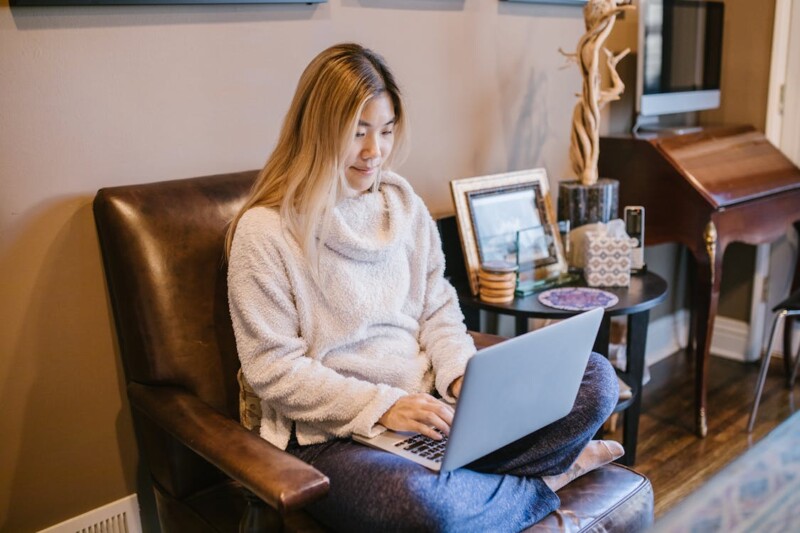You might wonder how to make money as a virtual interior designer. This field offers a unique opportunity to blend creativity with the convenience of working from anywhere. By offering services such as space planning, color consultations, and furniture selection, you can turn your passion for design into a profitable venture.
Charging a flat fee for your services is a common approach, allowing clients to know upfront what they’ll pay. Creating virtual design packages with detailed design plans and shopping lists can also provide extra value to your clients. You can also explore passive income avenues, like submitting designs to print-on-demand platforms.
Freelancing platforms and online job boards often list virtual interior design jobs that can pay from $20,000 to over $100,000 annually, depending on your experience and project load. This level of income shows significant potential for building a thriving business. Explore new methods and platforms, and continuously refine your style to attract more clients.

Virtual interior design is a modern approach to creating beautiful, functional spaces using digital tools and technologies.
It starts with virtual consultations. These sessions help you understand your client’s needs and preferences without visiting their home in person.
Next up is space planning. Here, you’ll use software to create floor plans and layouts, ensuring every piece of furniture fits perfectly. It’s like doing a puzzle but with couches and coffee tables!
The magic happens when realistic renderings are created. With advanced 3D tools, you can generate lifelike images of your proposed designs, allowing clients to see exactly how their space will look.
Here’s a little anecdote from my experience: I once worked in a tiny New York apartment where space planning was crucial. By creating a snug yet stylish layout, I turned a cramped spot into a cozy haven, all virtually!
You’ll also offer various virtual interior design services like shopping lists, mood boards, and style guides. These tools help clients bring your vision to life, even from afar.
Finally, consider offering follow-up consultations to assist with adjustments or final touches. This ongoing support can greatly improve client satisfaction.

To thrive as a virtual interior designer, you need skills and tools rooted in traditional design and modern technology. Let’s break it down.
Design Expertise:
You’ll need a strong foundation in interior design principles. If you have a degree in interior design, that’s a fantastic starting point. But don’t worry if you don’t—experience and a great portfolio can also speak volumes.
3D Visualization:
Clients love seeing realistic representations of their future spaces. Mastering 3D visualization and rendering tools, like SketchUp or AutoCAD, can set you apart.
Digital Tools:
Beyond design software, you’ll need tools for project management and client communication. Trello or Asana can help keep projects on track. Familiarizing yourself with Zoom and other virtual meeting platforms is crucial for client interactions.
Client-Centric Communication:
Listening to and understanding your client’s needs is fundamental. Articulating your design ideas and responding to their feedback will build trust and ensure successful outcomes.
Business Know-How:
A solid grasp of business skills is essential. Setting your prices, creating packages, sourcing work, and networking are all part of the gig. Websites and social media platforms can be great avenues for self-promotion.
AI Integration:
Leveraging AI tools to enhance design capabilities can also be a game-changer. Tools that aid in mood board creation or suggest design improvements based on trends can give you an edge.
In your journey, remember to keep learning and evolving. The design field is dynamic, and staying updated with the latest trends and tools will keep you competitive.
See Related: The Essential Secret Websites to Make Money Online This Year

Creating a portfolio is your first critical step. It’s your visual resume that highlights your style and expertise. Think of it as a clickable proof of your design talents.
Start by including a variety of projects. Work on different design styles and scales to show your versatility. An eclectic mix indicates that you can adapt to various client needs.
Take high-quality photos of your work. Good lighting and clear angles make a huge difference. You might not start with a professional camera, but smartphones nowadays can do a decent job.
Use a mix of real projects and 3D renderings. Many successful designers use platforms like HomeByMe. It’s a great tool to showcase your vision before materials and budgets enter the equation.
Make sure to update your portfolio consistently. Your design style will evolve, and your portfolio should reflect that evolution. Regular updates keep your work relevant and engaging.
Document your process. Include a few behind-the-scenes shots or sketches. Future clients love to see how a space takes shape from concept to completion.
Consider doing some free or discounted projects in the beginning. This can be for friends, family, or even local nonprofits. It’s a good way to build experience and show dedication to your craft.
Remember to brand your portfolio. Use a consistent theme and layout that speaks to your personal style. This makes it look professional and tells clients what to expect from working with you.
Lastly, remember to add testimonials from happy clients. Positive feedback enhances trust and shows that you can deliver on your promises.
Your portfolio tells your story. Make it captivating.

Alright, you’ve got your virtual interior design business up and running—now what? It’s time to find clients. This part might seem daunting, but it’s all about smart strategies and some hustle.
First, make use of social media. Platforms like Instagram and Pinterest are gold mines for visual-based businesses like interior design. Post regularly, showcase your work, and engage with your audience. Use hashtags wisely to reach potential clients looking for design inspiration.
Creating a business website is crucial. Ensure it’s mobile-friendly and prominently showcases your portfolio. Include client testimonials to build trust. Don’t forget an easy way for potential clients to contact you.
Online marketing is another key element. Invest in search engine optimization (SEO) to make your website more visible on search engines. Consider running pay-per-click (PPC) ads on Google and social media to target people actively seeking interior design services.
Participate in online communities dedicated to interior design. Websites and forums like Houzz and Reddit can be invaluable. Offer your expertise, answer questions, and subtly promote your services.
Networking is another strategy. Partner with real estate agents and home staging businesses. They can refer clients needing your design services after moving into a new home.
Finally, offering virtual consultations can attract clients who prefer flexibility or live outside your local area. This widens your client base, making it easier to secure more projects.
By effectively using these approaches, you’ll be well on your way to building a steady stream of clients for your virtual interior design business.

Creating a profitable and attractive pricing strategy for your virtual interior design services involves carefully balancing your costs and the perceived value of your work. This section explores methods to develop a well-thought-out pricing plan and understand the various costs involved.
A strategic pricing plan is essential. Start by evaluating your expertise, experience, and market trends. Offer a variety of packages such as basic consultations, full-service designs, and ongoing retainer services to cater to different client needs and budgets.
When setting your prices, consider the following:
To ensure competitiveness, periodically compare your rates with others in the industry.
Knowing the costs you incur is crucial to avoid pricing yourself too low. This includes startup costs like software subscriptions, marketing expenses, and setting up a home office. List all the initial investments.
Ongoing expenses could include monthly fees for design tools, payment processing fees, and promotional activities. Consider indirect costs like the internet and utilities and perhaps outsourcing certain tasks, such as administrative work.
Don’t forget the hidden costs. For example, if you spend hours on client communications or revisions, ensure these are accounted for in your pricing. Regularly review and adjust your prices to stay profitable while offering value to your clients.
See Related: Little-Known Ways to Make Money Online

Making a mark on social media can tremendously boost your virtual interior design business. Platforms like Instagram and Pinterest are goldmines for showcasing your portfolio.
Start by creating a visually appealing feed on Instagram. Post high-quality photos of your projects and use relevant hashtags to increase visibility. Sharing behind-the-scenes stories can also add a personal touch and engage your audience.
Engage actively. Responding promptly to comments and private messages builds credibility and fosters a sense of community. People love it when designers take the time to interact.
Pinterest is another excellent tool. Create boards that cater to various styles and themes. Pin your projects and other inspirational images to draw in users who might be interested in your services.
Utilize social media advertising. Small targeted ad campaigns on Instagram or Pinterest can reach potential clients genuinely interested in your services. Fine-tune your audience targeting based on interests related to design and decor.
Authenticity is key. Showcase your personality through your posts and share the highs and lows of your projects. This realness can attract clients who resonate with your style and approach.
Don’t forget about online presence beyond social media. Maintain a professional website where you can direct interested followers. Include a blog with design tips and case studies to establish yourself as an expert.
Bold all your key points to emphasize their importance and make your content easier to scan. These practical tips can effectively leverage your social media presence to grow your virtual interior design business.

Teaming up with furniture brands can significantly boost your income as a virtual interior designer. This approach opens multiple revenue streams, including affiliate marketing and commission-based sales.
When you collaborate with established brands, you gain access to their extensive catalog of quality pieces. This allows you to offer your clients a more diverse range of options, catering to different tastes and budgets. Additionally, these partnerships can enhance your credibility in the industry.
Here are a few ways to monetize these partnerships:
Commission-Based Sales: Some brands might offer higher commissions if you drive significant sales volume. Establishing a strong relationship with these brands can lead to exclusive deals and higher earnings.
Exclusive Collaborations: Partner with brands to create exclusive lines or limited-time offers. This adds variety to your portfolio and appeals to clients looking for unique pieces.
Research and approach brands whose style aligns with your design philosophy to get started. Use your social media presence or blog to highlight successful projects, showcasing how their furniture can transform a space. Authentic reviews and real-life applications can attract both brands and potential clients.
Remember, transparency is key. Always disclose your partnerships to maintain trust with your clients. This honest approach will build your reputation and ensure long-term virtual interior design business success.

You must invest in continuous learning to thrive as a virtual interior designer. Keeping up with modern trends and techniques is crucial, ensuring that your designs remain fresh and in demand. You’re not just a designer but part artist, psychologist, and tech guru.
One fun way to stay updated is through online courses. Platforms like Coursera and Udemy offer specialized courses in modern and traditional interior design styles. Whether you’re into mid-century modern or farmhouse chic, there’s always something new to learn.
Workshops and webinars are also excellent resources. Participants interact directly with experts and peers, making the learning experience engaging and hands-on. Plus, these events often cover the latest industry trends and innovations.
Remember to network. Join design forums and communities. Sharing your experiences and learning from others can be incredibly insightful. It’s like having a worldwide team of mentors!
Keeping an eye on industry publications is another great way to stay informed. Magazines like Architectural Digest and websites like Design Milk often feature articles on the latest trends and tools.
Software proficiency is essential. Mastering tools like AutoCAD, SketchUp, or 3D Max can significantly enhance marketability. Clients appreciate high-quality visuals and accurate renderings.
Lastly, always be curious. Whether it’s a new material, a unique color palette, or an innovative space-saving idea, curiosity will drive your growth. Remember, the design world is ever-evolving, and you want to evolve.
See Related: The Lazy Person’s Guide to Earning Money Online Effortlessly

Imagine, for a moment, being able to work from anywhere, creating beautiful spaces for clients across the globe. That’s exactly what happened to Claire Jones, a virtual interior designer from Boston. Claire started on platforms like Houzz and Instagram, where she showcased her portfolio and snagged her first few virtual clients.
Her big break came when she transformed a small studio apartment into a cozy, functional space. The client was so impressed that they shared Claire’s work on social media, gaining her even more visibility and leading to more projects. Claire’s key to success? Top-notch communication and attention to detail.
Take Mike Thompson for another example. Mike always had an eye for design but wasn’t sure how to turn his passion into a career. He initially offered free design consultations to build his portfolio. Over time, clients were more than willing to pay for his expertise.
Mike leveraged online design tools and offered virtual workshops. His clients appreciated the accessible and interactive nature of his sessions, and many returned for paid consultations. Client satisfaction was crucial in Mike’s journey, as positive reviews drove more business.
Then there’s Nina Patel, who narrowed her services to eco-friendly design solutions. Nina’s commitment to sustainability resonated with environmentally-conscious clients. She not only transformed spaces but also educated homeowners on sustainable practices.
Remember, building client satisfaction is foundational. Happy clients are your best advocates. They will share your work and refer you to new prospects. Each transformation you complete successfully is another step towards establishing a thriving virtual interior design business.
Last updated: September 14, 2025